NVIDIA GeForce 8800 GT: The Only Card That Matters
by Derek Wilson on October 29, 2007 9:00 AM EST- Posted in
- GPUs
Out with the Old, In with the New: 8800 GT vs. 7950 GT and 1950 XT
Many gamers are likely still rocking either GeForce 7 or Radeon X1k based hardware. We understand that gamers don't have a continuous $250 fund in order to upgrade their graphics card whenever something new comes out. A good many of us have been waiting (and not so patiently) for a DX10 class graphics card in the $200 - $250 range. The 8800 GTS 320MB has been a great option for those who could afford it, but the 8600 GTS and 2600 XT really haven't delivered anything close to the kind of performance we wanted for the price.
We don't expect many people to "upgrade" to an 8800 GT from an 8800 GTS 320MB, we do expect those who spent at least $250+ on a previous generation DX9 class card to be interested in moving up to a current generation product. In order to paint a good picture of what gamers with older hardware can expect, we decided to pick only a couple reference points. While we could have tested everything out there, we felt that looking at the absolute fasted DX9 class card available (the Radeon X1950 XTX) and a card that offered good performance at between $250 and $300 (the GeForce 7950 GT) would give us a fairly complete picture of what to expect.
The reason this really makes sense, as we will show in a second, is that the 8800 GT absolutely blows away every DX9 class part out there. The only thing we really need to show is what kind of performance improvement you can expect depending on the type of hardware you own. If you own the best possible previous generation card, you get a very good performance improvement at most resolutions. If you own a previous generation card from the same price segment, you can expect a huge improvement in performance across the board. That said, feast your eyes on what everyone who hasn't upgraded yet can look forward to (in addition to all the added features of the GeForce 8 Series).
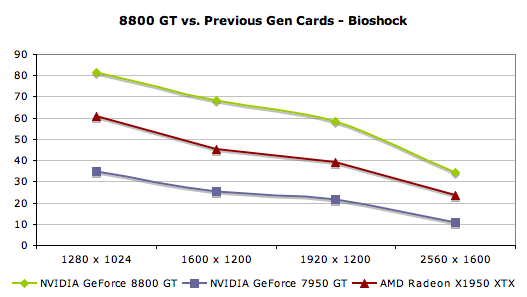
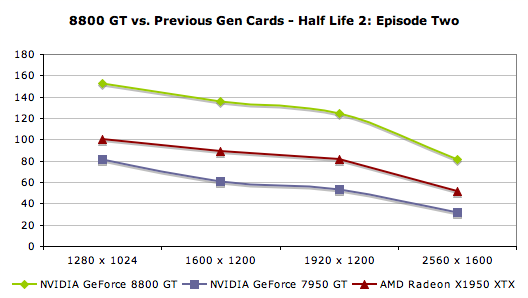
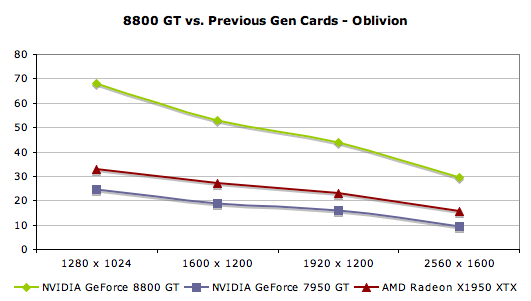
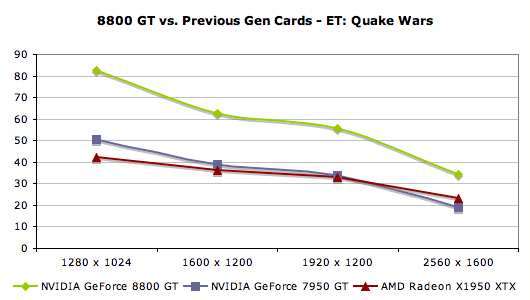
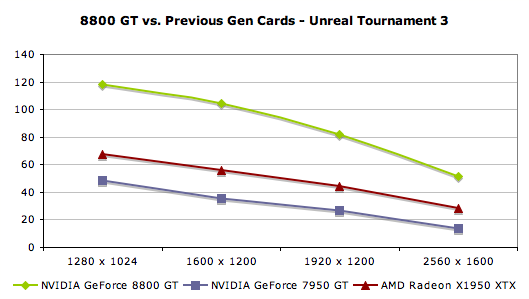
Many gamers are likely still rocking either GeForce 7 or Radeon X1k based hardware. We understand that gamers don't have a continuous $250 fund in order to upgrade their graphics card whenever something new comes out. A good many of us have been waiting (and not so patiently) for a DX10 class graphics card in the $200 - $250 range. The 8800 GTS 320MB has been a great option for those who could afford it, but the 8600 GTS and 2600 XT really haven't delivered anything close to the kind of performance we wanted for the price.
We don't expect many people to "upgrade" to an 8800 GT from an 8800 GTS 320MB, we do expect those who spent at least $250+ on a previous generation DX9 class card to be interested in moving up to a current generation product. In order to paint a good picture of what gamers with older hardware can expect, we decided to pick only a couple reference points. While we could have tested everything out there, we felt that looking at the absolute fasted DX9 class card available (the Radeon X1950 XTX) and a card that offered good performance at between $250 and $300 (the GeForce 7950 GT) would give us a fairly complete picture of what to expect.
The reason this really makes sense, as we will show in a second, is that the 8800 GT absolutely blows away every DX9 class part out there. The only thing we really need to show is what kind of performance improvement you can expect depending on the type of hardware you own. If you own the best possible previous generation card, you get a very good performance improvement at most resolutions. If you own a previous generation card from the same price segment, you can expect a huge improvement in performance across the board. That said, feast your eyes on what everyone who hasn't upgraded yet can look forward to (in addition to all the added features of the GeForce 8 Series).















90 Comments
View All Comments
AggressorPrime - Monday, October 29, 2007 - link
I made a typo. Let us hope they are not on the same level.ninjit - Monday, October 29, 2007 - link
This page has my very confused:http://www.anandtech.com/video/showdoc.aspx?i=3140...">http://www.anandtech.com/video/showdoc.aspx?i=3140...
The text of the article goes on as if the GT doesn't really compare to the GTX, except on price/performance:
Yet all the graphs show the GT performing pretty much on par with the GTX, with at most a 5-10fps difference at the highest resolution.
I didn't understand that last sentence I quoted above at all.
archcommus - Monday, October 29, 2007 - link
This is obviously an amazing card and I hope it sets a new trend for getting good gaming performance in the latest titles for around $200 like it used to be, unlike the recent trend of having to spend $350+ for high end (not even ultra high end). However, I don't get why a GT part is higher performing than a GTS, isn't that going against their normal naming scheme a bit? I thought it was typically: Ultra -> GTX -> GTS -> GT -> GS, or something like that.mac2j - Monday, October 29, 2007 - link
I've been hearing rumors about an Nvidia 9800 card being released in the coming months .... is that the same card with an outdated/incorrect naming convention or a new architecture beyond G92?I guess if Nvidia had a next-gen architecture coming it would explain why they dont mind wiping some of their old products off the board with the 8800 GT which seems as though it will be a dominant part for the remaining lifetime of this generation of parts.
MFK - Monday, October 29, 2007 - link
After lurking on Anandtech for two layout/design revisions, I have finally decided to post a comment. :DFirst of all hi all!
Second of all, is it okay that nVidia decided not to introduce a proper next gen part in favour of this mid range offering? Okay so its good and what not, but what I'm wondering is, something that the article does not talk about, is what the future value of this card is. Can I expect this to play some upcoming games (Alan Wake?) on 1600 x 1200? I know its hard to predict, but industry analysts like you guys should have some idea. Also how long can I expect this card to continue playing games at acceptable framerates? Any idea, any one?
Thanks.
DerekWilson - Monday, October 29, 2007 - link
that's a tough call ....but really, it's up to the developers.
UT3 looks great in DX9, and Bioshock looks great in DX10. Crysis looks amazing, but its a demo, not final code and it does run very slow.
The bottom line is that developers need to balance the amazing effects they show off with playability -- it's up to them. They know what hardware you've got and they chose to push the envelope or not.
I konw that's not an answer, sorry :-( ... it is just nearly impossible to say what will happen.
crimson117 - Monday, October 29, 2007 - link
How much ram was on the 8800 GT used in testing? Was is 256 or 512?NoBull6 - Monday, October 29, 2007 - link
From context, I'm thinking 512. Since 512MB are the only cards available in the channel, and Derek was hypothesizing about the pricing of a 256MB version, I think you can be confident this was a 512MB test card.DerekWilson - Monday, October 29, 2007 - link
correct.256MB cards do not exist outside NVIDIA at this point.
ninjit - Monday, October 29, 2007 - link
I was just wondering about that too.I thought I missed it in the article, but I didn't see it in another run through.
I see I'm not the only one who was curious